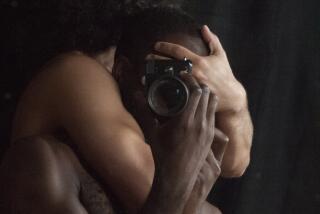Beyond the statistics
- Share via
ABOUT two weeks ago, Whitney Pierce and Hanni Rosenfeld spent a weekend with their new friend Pam Coffey in South-Central Los Angeles. During their three days together they ran errands, got their hair braided and went to a pizzeria. Although this may not sound unusual, for Pierce and Rosenfeld it was a foray into new territory. The former is an art history major at UCLA; the latter an alumnus who works at the university’s department of world arts and cultures. Coffey is an African American woman with HIV -- a scenario that is becoming more commonplace, as rates of new infection in the United States rise among women of her ethnic group. But Pierce and Rosenfeld are making sure that everybody understands Coffey is not a statistic. They have created a photographic assemblage with words to depict various facets of her life.
The piece is one of a dozen works put together by teams of students and a few nonstudents for an art show on the second floor of UCLA’s Glorya Kaufman Hall: “HIV-Positive in Los Angeles: Twelve Stories.” Each group paired one writer and one photographer who spent a weekend or slightly longer with a person with HIV or AIDS in L.A. The stories are told in the subjects’ own words, through the vision of the project participants via works that resemble blown-up pages of magazine layouts. Adjacent to each is a professional portrait of the individual, taken by Gideon Mendel, the show’s director.
“HIV/AIDS is a huge issue in America that isn’t addressed at all,” Mendel says. The London-based commercial photographer for publications such as National Geographic has spent 14 years chronicling the disease in Africa. His passion and commitment are exemplified in his book “A Broken Landscape: HIV & AIDS in Africa.”
The book was required reading for UCLA’s “Make Art/Stop AIDS” course. So it wasn’t a leap when its instructor, David Gere -- the director of the Art/Global Health Center at UCLA, co-chair of the department of world arts and cultures, and founder of the Make Art/Stop AIDS network of scholars, artists and activists -- approached Mendel about the prospect of teaching a class. Mendel proposed something more creative, collaborative and hands-on, and the seed for “HIV-Positive in Los Angeles” was planted. The show, Mendel says, acts as a “tool that can be used to educate and mobilize and make a piece of visual activism.”
So it was that Kyla Searle, a metropolitan studies major, and her project partner Lauren Ross, a world arts and cultures major, spent a weekend getting to know Phill Wilson. He is the executive director of the Black AIDS Institute, an L.A.-based nonprofit policy center, and has had HIV for 25 years and AIDS for 10. The young women accompanied him on routine visits to the hospital, where he had his blood drawn, as well as to a yoga teachers’ banquet at which he was honored. The result: their assemblage piece titled “Still Here.”
Despite how one might imagine portraits in a show about HIV/AIDS would look, “Pretty much everyone in this exhibit looks really healthy. They’re flourishing,” Searle says. She cites the availability of anti-retroviral drugs as one reason. Another unspoken reason -- a zest for life and survival spirit -- seems to be the subtle quality that the artist-activist teams hope to capture.
On the wall opposite this work hangs the piece “Yo Soy Un Milagro” by Emily Feldstein and Cristina Coleman-Rosa. It includes a photographic portrait of Bamby Salcedo, a transgender person with HIV, and showcases her hauntingly poetic words, “HIV is my shadow. Everywhere I go, It’s right there.” Another work focuses on a man who has empowered himself by tattooing plus-signs all over his body, referencing his HIV-positive status.
WHILE the show enlisted students from diverse backgrounds, including biology and art history majors, it also drew on non-academes. One of them, Joe Hogan, who worked for CBS for 12 years, found out about the exhibit -- and discovered a new passion for photography and activism -- when his friend Gere asked him to get involved. His piece “3” takes the show’s collaborative concept to a new level: Its subject is HIV-positive choreographer Simeon Den; Hogan has been HIV-positive since 1986; and his writer-collaborator Marcelle Little’s father died of AIDS-related complications.
“We thought about the evolution of a dance and how that is a metaphor in many ways for HIV and the AIDS movement in this country,” Hogan says. The work is a sort of group portrait of their weekend experience together, much of which was spent in dance studios.
“This body of work is talking about the experience of a great diversity of people,” Mendel says of the exhibition. “It reflects the great diversity of the disease.”
*
‘HIV-Positive in Los Angeles’
Twelve Stories
Where: Glorya Kaufman Hall, 120 Westwood Plaza, UCLA, Westwood
When: 8 a.m.-5 p.m. Mondays-Wednesdays and Fridays, 8 a.m.-8 p.m. Thursdays, noon-5 p.m. Saturdays-Sundays
Ends: March 25
Info: (310) 794-9208, www.wac.ucla.edu/AGHindex.php
More to Read
The biggest entertainment stories
Get our big stories about Hollywood, film, television, music, arts, culture and more right in your inbox as soon as they publish.
You may occasionally receive promotional content from the Los Angeles Times.










